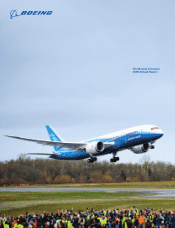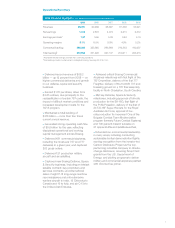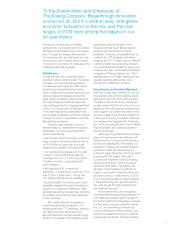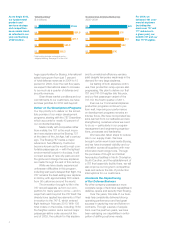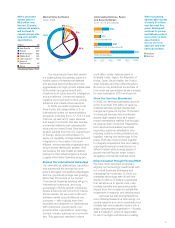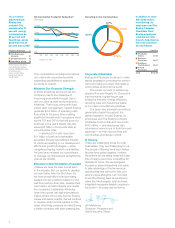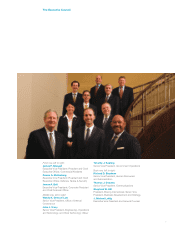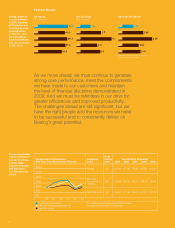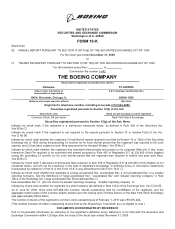Boeing 2009 Annual Report Download - page 6
Download and view the complete annual report
Please find page 6 of the 2009 Boeing annual report below. You can navigate through the pages in the report by either clicking on the pages listed below, or by using the keyword search tool below to find specific information within the annual report.
4
Commercial Airplane Deliveries
2005–2009
05
06
07
08
09
290
398
441
375
481
Total Backlog*
($ in billions)
05
06
07
08
09
205.2
250.2
327.1
351.9
315.6
*Total backlog includes contractual and un-
obligated backlog. See page 20 of the 10-K.
As we begin 2010,
our fundamental
product-and-
services strategy
and competitive-
ness remain intact,
as refl ected in our
year-end backlog
of $316 billion.
For 2009, we
delivered 481 com-
mercial airplanes
(including the
most-ever 737 and
777 deliveries in
a given year), our
6,000th 737 and our
fi rst 777 Freighter.
huge opportunities for Boeing. International
sales have grown from just 7 percent
of total defense revenues in 2004 to 15
percent in 2009. Over the next fi ve years,
we expect international sales to increase
to as much as a quarter of defense and
security revenues.
Given these market conditions and our
commitments to our customers, we have
set clear priorities for 2010 and beyond:
Deliver on Our Development Programs
Our top priority is to deliver on the incred-
ible promise of our major development
programs, starting with the 787 Dreamliner,
which accounts for nearly 40 percent of
our contracted backlog.
Made mostly with composites rather
than metals, the 787 is the most impor-
tant new airplane since the Boeing 707
at the dawn of the Jet Age, half a century
ago. The Boeing 787 marks a major
advance in fuel effi ciency. It will soon
become known as the world’s most com-
fortable passenger jet — with the lightest
environmental footprint in its class. It will
connect scores of new city-pairs around
the globe and change the way airplanes
are made through the rest of this century.
While we have clearly experienced
unforeseen diffi culties in this program,
including last year’s delayed fi rst fl ight, the
787 remains the best-selling new airplane
in history, with approximately 850 orders
from 56 customers around the world.
The innovation brought to life in the
787 should separate us from our com-
petitors for many years to come — and in
ways that reach beyond the 787 itself. We
already have applied key elements of that
innovation to the 747-8, which entered
fl ight testing in February 2010. With 108
total orders on the books, including 76 for
the freighter version and a second major
passenger-airline order secured at the
end of 2009, the outlook for this airplane
and its unmatched effi ciency remains
solid despite temporary weakness in the
demand for very large airplanes.
As testing of both airplanes contin-
ues, their production ramp-ups are also
progressing. We plan to deliver our fi rst
787 and 747-8 Freighter late this year,
and our fi rst passenger variant of the
747-8 in the fourth quarter of 2011.
Even as our Commercial Airplanes
production programs continue to per-
form well, improving our performance
on development programs remains an
intense focus. We have incorporated les-
sons learned from our setbacks and are
strengthening ourselves where we need
to do so — particularly in our program-
management and engineering organiza-
tions, processes and leadership.
We have also taken steps to reduce
risk in our supply chain. We have
brought certain work back inside Boeing,
and we have increased visibility and co-
ordination across all suppliers with new
information technology tools. Through
the purchase of Vought and Global
Aeronautica facilities in North Charleston,
South Carolina, and the establishment of
a 787 fi nal assembly facility there, we will
also improve our long-term competitive-
ness and reduce the risk of production
interruptions for our customers.
Accelerate the Repositioning
of Our Defense Business
No other company possesses a more
complete range of technical capabilities in
defense, space and security than Boeing.
Over the years, this side of our busi-
ness has consistently delivered strong
operating performance and had great
success in capturing new and follow-on
contracts. Through a series of acquisi-
tions over the past two years, we have
been reshaping our capabilities in antici-
pation of shifting customer needs.

